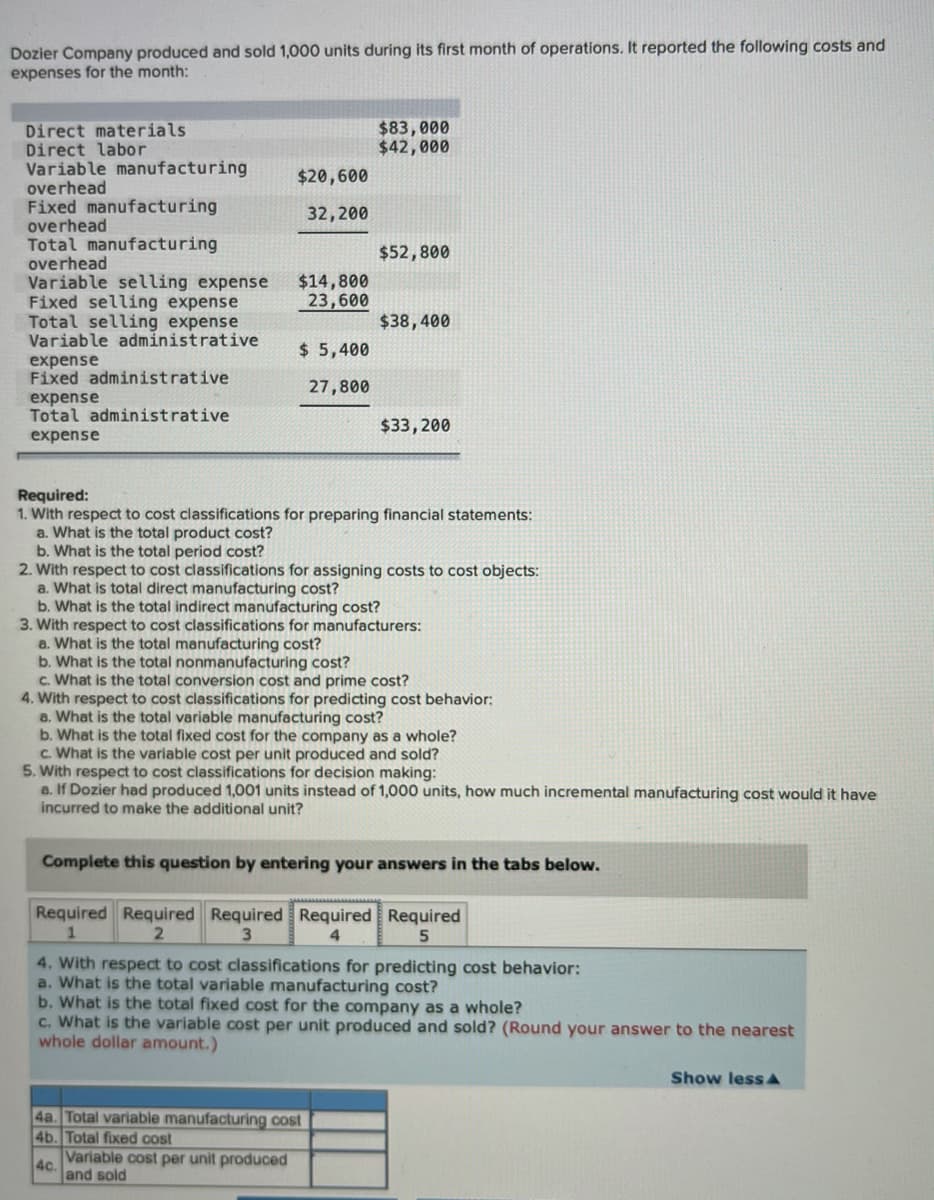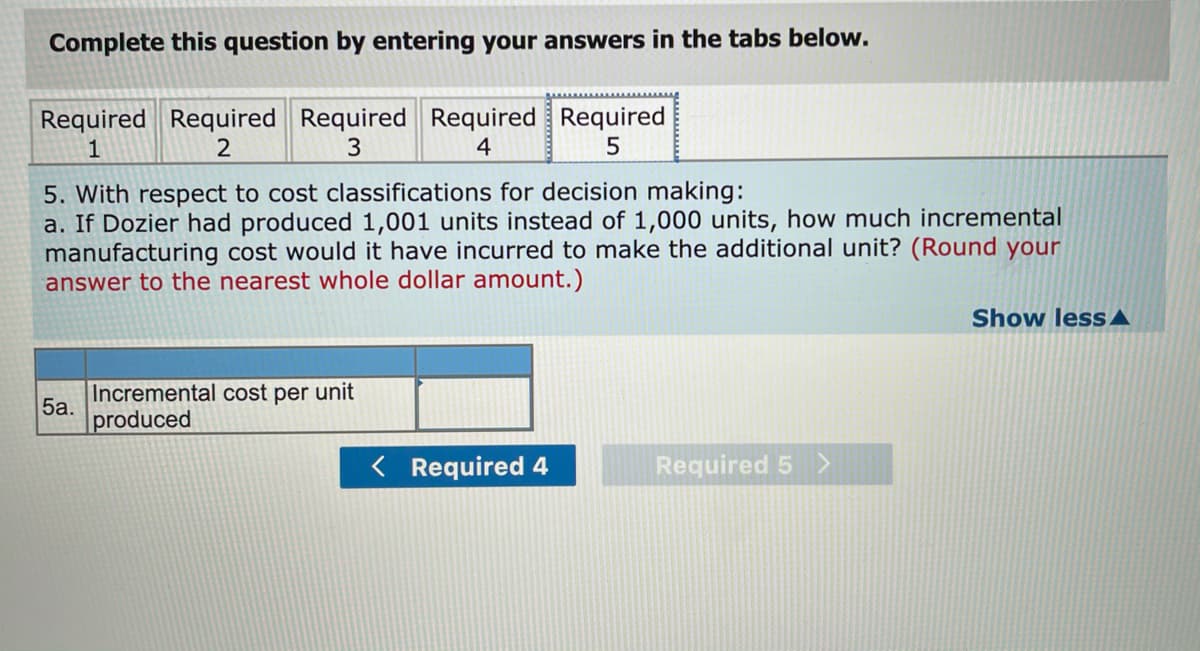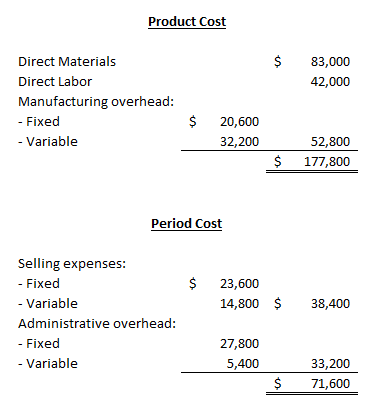$83,000 $42,000 Direct materials Direct labor Variable manufacturing overhead Fixed manufacturing overhead Total manufacturing overhead Variable selling expense Fixed selling expense Total selling expense Variable administrative $20,600 32,200 $52,800 $14,800 23,600 $38,400 $ 5,400 expense Fixed administrative 27,800 expense Total administrative $33,200 expense
$83,000 $42,000 Direct materials Direct labor Variable manufacturing overhead Fixed manufacturing overhead Total manufacturing overhead Variable selling expense Fixed selling expense Total selling expense Variable administrative $20,600 32,200 $52,800 $14,800 23,600 $38,400 $ 5,400 expense Fixed administrative 27,800 expense Total administrative $33,200 expense
Cornerstones of Cost Management (Cornerstones Series)
4th Edition
ISBN:9781305970663
Author:Don R. Hansen, Maryanne M. Mowen
Publisher:Don R. Hansen, Maryanne M. Mowen
Chapter2: Basic Cost Management Concepts
Section: Chapter Questions
Problem 21E: Ellerson Company provided the following information for the last calendar year: During the year,...
Related questions
Question

Transcribed Image Text:Dozier Company produced and sold 1,000 units during its first month of operations. It reported the following costs and
expenses for the month:
$83,000
$42,000
Direct materials
Direct labor
Variable manufacturing
overhead
Fixed manufacturing
overhead
Total manufacturing
overhead
Variable selling expense
Fixed selling expense
Total selling expense
Variable administrative
$20,600
32,200
$52,800
$14,800
23,600
$38,400
$ 5,400
expense
Fixed administrative
expense
Total administrative
27,800
$33,200
expense
Required:
1. With respect to cost classifications for preparing financial statements:
a. What is the total product cost?
b. What is the total period cost?
2. With respect to cost classifications for assigning costs to cost objects:
a. What is total direct manufacturing cost?
b. What is the total indirect manufacturing cost?
3. With respect to cost classifications for manufacturers:
a. What is the total manufacturing cost?
b. What is the total nonmanufacturing cost?
c. What is the total conversion cost and prime cost?
4. With respect to cost classifications for predicting cost behavior:
a. What is the total variable manufacturing cost?
b. What is the total fixed cost for the company as a whole?
c. What is the variable cost per unit produced and sold?
5. With respect to cost classifications for decision making:
a. If Dozier had produced 1,001 units instead of 1,000 units, how much incremental manufacturing cost would it have
incurred to make the additional unit?
Complete this question by entering your answers in the tabs below.
Required Required Required Required Required
3.
5
4. With respect to cost classifications for predicting cost behavior:
a. What is the total variable manufacturing cost?
b. What is the total fixed cost for the company as a whole?
c. What is the variable cost per unit produced and sold? (Round your answer to the nearest
whole dollar amount.)
Show less A
4a. Total variable manufacturing cost
4b. Total fixed cost
Variable cost per unit produced
4c.
and sold

Transcribed Image Text:Complete this question by entering your answers in the tabs below.
Required Required Required Required Required
1
2
3
4
5. With respect to cost classifications for decision making:
a. If Dozier had produced 1,001 units instead of 1,000 units, how much incremental
manufacturing cost would it have incurred to make the additional unit? (Round your
answer to the nearest whole dollar amount.)
Show lessA
Incremental cost per unit
5а.
produced
< Required 4
Required 5 >
Expert Solution
Step 1: Product and Period Cost
Product cost: Product cost of a product refers to the manufacturing cost of producing one unit of a product. It includes, direct material cost, direct labor cost, and factory or manufacturing overhead.
Period cost: Period costs are the costs which are not allocable to a particular unit of product and hence to be charged off against the revenue at the end of a period. It includes all the general selling and administrative overhead.

Total product cost: $177,800
Total period cost: $71,600
Trending now
This is a popular solution!
Step by step
Solved in 5 steps with 5 images

Knowledge Booster
Learn more about
Need a deep-dive on the concept behind this application? Look no further. Learn more about this topic, accounting and related others by exploring similar questions and additional content below.Recommended textbooks for you

Cornerstones of Cost Management (Cornerstones Ser…
Accounting
ISBN:
9781305970663
Author:
Don R. Hansen, Maryanne M. Mowen
Publisher:
Cengage Learning

Managerial Accounting
Accounting
ISBN:
9781337912020
Author:
Carl Warren, Ph.d. Cma William B. Tayler
Publisher:
South-Western College Pub

Principles of Cost Accounting
Accounting
ISBN:
9781305087408
Author:
Edward J. Vanderbeck, Maria R. Mitchell
Publisher:
Cengage Learning

Cornerstones of Cost Management (Cornerstones Ser…
Accounting
ISBN:
9781305970663
Author:
Don R. Hansen, Maryanne M. Mowen
Publisher:
Cengage Learning

Managerial Accounting
Accounting
ISBN:
9781337912020
Author:
Carl Warren, Ph.d. Cma William B. Tayler
Publisher:
South-Western College Pub

Principles of Cost Accounting
Accounting
ISBN:
9781305087408
Author:
Edward J. Vanderbeck, Maria R. Mitchell
Publisher:
Cengage Learning

Managerial Accounting: The Cornerstone of Busines…
Accounting
ISBN:
9781337115773
Author:
Maryanne M. Mowen, Don R. Hansen, Dan L. Heitger
Publisher:
Cengage Learning

Principles of Accounting Volume 2
Accounting
ISBN:
9781947172609
Author:
OpenStax
Publisher:
OpenStax College

Financial And Managerial Accounting
Accounting
ISBN:
9781337902663
Author:
WARREN, Carl S.
Publisher:
Cengage Learning,